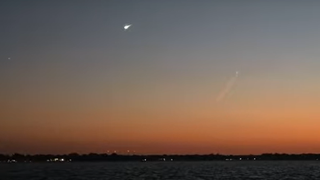Space
Explore Space
Editor's Picks
Latest about Space

Supernova that lit up Earth's skies 843 years ago has a flowering 'zombie star' at its heart — and it's still exploding
By Harry Baker published
A new animated map sheds light on the superhot "zombie star" at the heart of a nebula leftover from a distant supernova witnessed by astronomers in 1181. The remains of the stellar explosion are unusually wonky and are still exploding at a constant speed.

'Killer electrons' play pinball with space weather around Earth
By Robert Lea published
"Killer electrons" stashed in radiation belts around Earth could be dislodged by lightning to create a game of "cosmic pinball" that influences space weather around our planet.

4 large asteroids, including a skyscraper-size 'city killer,' will zoom past Earth in a 12-hour span tomorrow (Oct. 24)
By Harry Baker published
Four "potentially hazardous" space rocks, which are between 100 and 580 feet across, will all make their closest approaches to Earth within less than 12 hours of one another on Thursday (Oct. 24). Two of them were only discovered earlier this month.

Boeing-made satellite shatters in orbit, and nobody knows why
By Ben Turner published
Intelsat 39 being launched from French Guiana aboard an Ariane 5 rocket in 2019.

Watch huge fireball blaze over Lake Erie in stunning videos
By Sascha Pare published
A fiery meteor shot across the sky above the Great Lakes on Monday (Oct. 21) just after sunset, stunning witnesses from Michigan to New York, Kentucky and North Carolina.

How old is planet Earth?
By Briley Lewis published
How old is Earth? Our planet's age is known from a variety of sources, from rocks on our own planet to ones from the moon.

Euclid telescope reveals 1st section of largest-ever 3D map of the universe — and there's still 99% to go
By Ben Turner published
The first piece of the Euclid space telescope's map of the universe is crammed with 14 million galaxies and 100 million sources of light. The mapping project is now 1% done.

Tiny photosynthetic aliens could be lurking in hidden bubbles in Mars' ice — and could soon be replicated on Earth
By Harry Baker published
A new NASA-led study suggests that photosynthetic microbes could thrive in hidden bubbles of meltwater below patches of ice on Mars. This could be one of the easiest places to search for extraterrestrial life "anywhere in the universe," the team says.
Sign up for the Live Science daily newsletter now
Get the world’s most fascinating discoveries delivered straight to your inbox.





